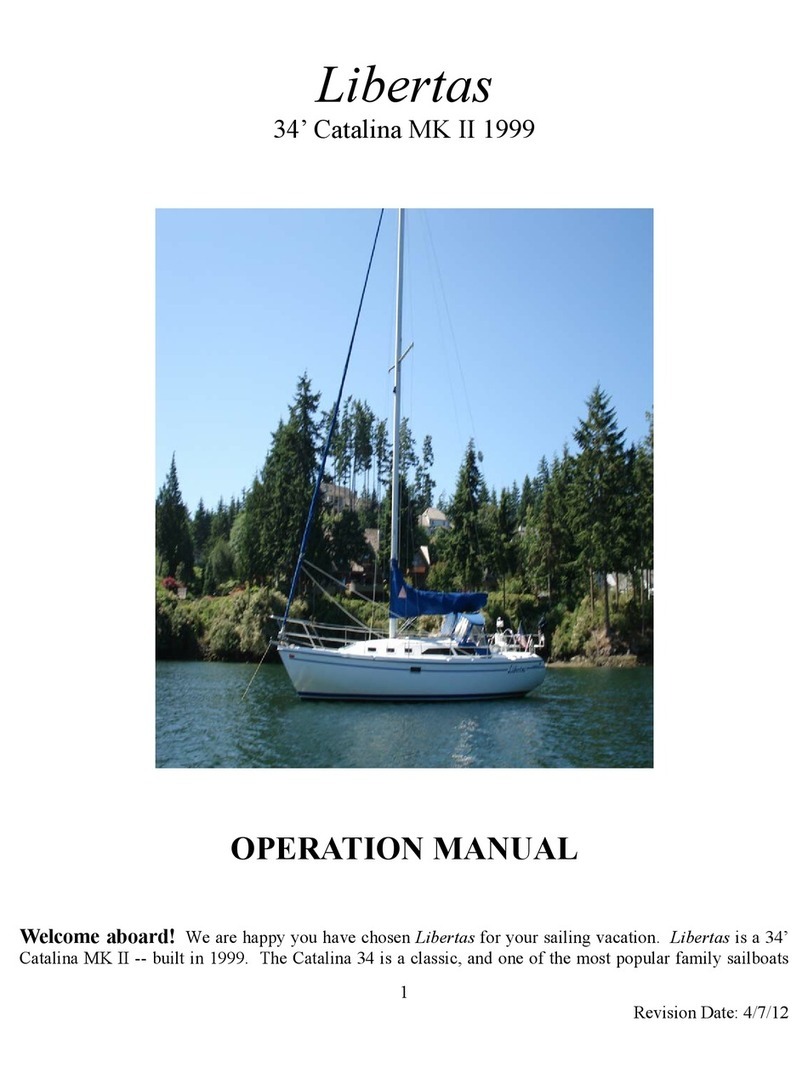
Fittings
Marine fittings today need little maintenance. Deck hardware should be hosed down with fresh water
after each sail in salt water. Stainless steel fittings such as pulpits and lifeline stanchions should be
cleaned and waxed periodically to maintain their appearance. Winches require occasional cleaning and
lubrication. Where possible, a maintenance brochure for your winches has been included in this manual.
Mast head fittings, halyard sheaves, etc., should be inspected, cleaned and lubricated periodically.
Keep your equipment clean of dirt and salt.
Spars
Like all other boat fittings, mast and booms suffer from salt water, air and spray. These should be kept
waxed, where possible and, at least, always hosed down with fresh water. Always see that the halyards
are tied off, away from the mast. This will eliminate slapping in the wind and subsequent marking of the
mast. Keep tack pin (located on front of boom) well lubricated, as without proper lubrication-the
stainless steel pin may become seized in the aluminum gooseneck casting.
Find a high pressure nozzle and shoot fresh water to the top of the mast and spreaders. This will help
keep your sails clean, too, as they rub on the mast and spreaders.
Inspect spreaders and spreader brackets for signs of fatigue. See that ends of spreaders are wired and
well covered with tape to prevent wear on the sails.
3.8 Sail Maintenance
Sails should never be put away wet. If they are wet after sailing, leave them in loose bundles and dry
them at your first opportunity.
For most problems such as common dirt, dried or caked salt, etc., try scrubbing the surface with a soft
bristled brush and liquid detergent. Avoid harsh powder detergents and stiff brushes, as they may
damage the finish or stitching. This approach should work nicely for most applications. More severe
stains can be taken care of by the following:
*IMPORTANT: For white sails only.
Blood: Soak the stained portion for 10-20 minutes in a solution of bleach (Clorox) and warm water;
generally 10 parts water to 1 part bleach. Scrub and repeat, if necessary. Rinse thoroughly - particularly
nylon - and dry completely.
Oil, Grease, Tar and Wax: Warm water, soap and elbow grease seem to be effective. On hard stains,
Propriety Stain Remover and dry cleaning fluids should do the trick. Be careful to remove all fluids, as
they can soften the various resinated coatings on sailcloth.
Rust and Metallic Stains: These types of stains are very often the most frustrating and difficult to
remove. First, scrub with soap and water, then apply acetone, M.E.K., or alcohol. As a last resort, you
might try a diluted mixture (5%) of oxalic acid soaked for 15-20 minutes. Hydrochloric acid, 2 parts to
100 in warm water, will also work.
Mildew: Hot, soapy water with a little bleach will generally prevail. After scrubbing, leave the solution on
the fabric for a few minutes and rinse thoroughly. When using a bleach, a residual chlorine smell may
be present after rinsing. A 1% solution of Thiosulphate (photographer's hypo) should remove all chlorine
traces. Here, again, rinse and dry well.
Paint and Varnish: Acetone and M.E.K. should remove most common paint and stains. In most cases,
varnish can be removed with alcohol.
Catalina 22 Owner's Manual for 1987
http://www.catalina22.org/manuals/mnl87/handbook.htm




























